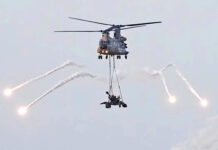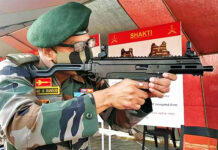Beyond ground warfare the battlefield is getting increasingly complex and unpredictable. The character of war is changing. This exemplifies the advancements made in the electromagnetic spectrum, cyber, space and air domains, among others. These higher-end capabilities have atrophied over 35 years of counter-insurgency and counter-terror operations against technologically inferior adversaries.
With the advent of new technologies that have enabled new domains of warfare, the Indian Armed Forces must begin exploring how to exploit multi-domain operations as opposed to just land, air and maritime domain.
Cyber, Space and the Electromagnetic spectrum did not exist during previous conflicts.
Distributed, multi-domain and joint all domain operations (MDO and JADO) are fast becoming the defining doctrines of this new era.
Essentially, they are the synchronisation of aircraft, ground forces and vehicles, satellites and ships, their systems and all sources of data. Together they deliver a complete picture of the battlespace and empower personnel – in theatre or command – to quickly make decisions that drive action.
Cyberspace is a critical element of this new age of combat; as the electromagnetic spectrum itself – a string of frequencies from radio to microwaves, visible light, X-rays and gamma rays which transmit data – may become. The US, UK and others are looking ever more closely at it.
For future MDOs, artificial intelligence and machine learning will play a critical role, helping decipher data, determine its operational relevance and then present informed options for decision-making jointly across all Services.
If the Army can bring them together along with manoeuvre warfare, which is the Army’s strength, and integrate them at the time and point of choosing, this can open windows of domain superiority leading to denial of access and areas.
For example, Cyberspace can provide opening in the air domain by taking air defence weapons offline, which will then create openings for land and maritime, leading to a new level of complication for the enemy.
For example, when the enemy is engaging you with artillery or you are being engaged from the air, another domain brings in its effects to bear and neutralises the threat. It means you have to look at what equipment you need, what kind of network you need, what kind of training you need, and a lot of interoperability and inter-connectivity.
Cyber is ubiquitous across the battlefield and warfare. The Army has not yet made a beginning to use this domain to facilitate own operations or to disrupt the enemy’s. It does not have cyber forces. Cyber advisories and guidelines do not make up doctrines or methods to adopt in operations, much less in an integrated manner with other domains.
Russian forces have very expertly used the cyber domain to facilitate targeting with their artillery against Ukrainian ground forces demonstrating the ability to take action in one domain and produce an effect or dominate another domain.
The US Navy and Air Force are working on new technologies and capabilities through programmes like Project Overmatch and the Advanced Battle Management System, respectively. Together both forces have developed more than a dozen projects they are collaborating on, bringing all domains together to share and utilise information and assess and respond in synergy.
In the UK, this is being addressed by what the MoD calls the Digital Backbone, a digital transformation programme that will allow information sharing and communication regardless of the hardware being used.
We must at least learn from events in Ukraine, evolve our concepts, map out a phased delivery approach and experiment.
Air-Land Battle doctrine, once the flavour of studies at the Army War College involved two domains – air and land. That alone will not work in the future.
The Armed Forces are not currently organized or trained in this manner. The Training Commands of the three Services have a role and responsibility to integrate these capabilities.
Multi-domain warfare is something on which the Indian Armed Forces have to start at the very beginning and approach it from a joint aspect. Single service approach will just not do.
The goal is to better enable the Services to fight together effectively in all domains simultaneously, to present multiple dilemmas for the enemy. That will mean looking at how do we organize, how to equip and how to train to do that.
A new mindset is needed to enable multi-domain action.



















